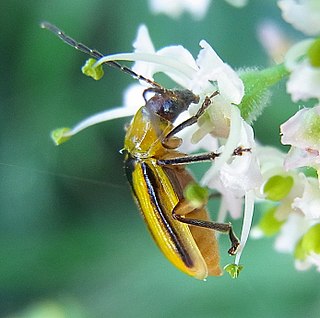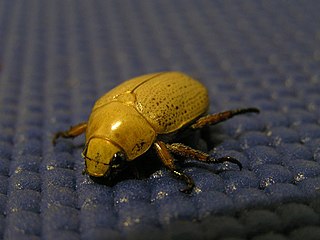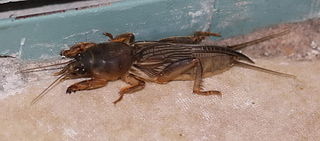
The Japanese beetle is a species of scarab beetle. The adult measures 15 mm (0.6 in) in length and 10 mm (0.4 in) in width, has iridescent copper-colored elytra, and a green thorax and head. Due to the presence of natural predators, the Japanese beetle is not considered a pest in its native Japan, but in North America and some regions of Europe, it is a noted pest to roughly 300 species of plants. Some of these plants include rose bushes, grapes, hops, canna, crape myrtles, birch trees, linden trees, and others.

The common cockchafer, colloquially called the Maybug, Maybeetle, or doodlebug, is a species of scarab beetle belonging to the genus Melolontha native to Europe. It is one of several closely related and morphologically similar species of Melolontha called cockchafers, alongside Melolontha hippocastani. The adults and larvae feed on plants, and are regarded as serious agricultural pests of crops such as grasses and fruit trees.

The Western corn rootworm, Diabrotica virgifera virgifera, is one of the most devastating corn rootworm species in North America, especially in the midwestern corn-growing areas such as Iowa. A related species, the Northern corn rootworm, D. barberi, co-inhabits in much of the range and is fairly similar in biology.

Phyllophaga is a very large genus of New World scarab beetles in the subfamily Melolonthinae. Common names for this genus and many other related genera in the subfamily Melolonthinae are May beetles, June bugs, and July beetles. They range in size from 12 to 35 mm and are blackish or reddish-brown in colour, without prominent markings, and often rather hairy ventrally. These beetles are nocturnal, coming to lights in great numbers.

The Mexican bean beetle is a species of lady beetle that can be an agricultural pest. It is one of the few North American lady beetles that feed on plants rather than other insects. It is found throughout Mexico and the eastern United States, and is abundant in the wetter and more heavily irrigated areas west of the Rocky Mountains. It does not tolerate extremely dry areas.

Diaprepes abbreviatus, also known as the diaprepes root weevil, citrus root weevil and sugarcane rootstock borer weevil, is a species of weevil that is native to the Caribbean, where in Spanish it is colloquially called chichí. It has become an invasive pest in several locations in the United States.

Dermolepida albohirtum, the cane beetle, is a native Australian beetle and a pest of sugarcane. Adult beetles eat the leaves of sugarcane, but greater damage is done by their larvae hatching underground and eating the roots, which either kills or stunts the growth of the plant. The beetles can also be found in the Philippines and are known there by the local name salagubang.

Anoplognathus pallidicollis is a relatively large beetle of the family Scarabaeidae, native to Australia. The beetle has a life span of 24 months and it grows up to 20 mm in length. Adults were once common in the summer months, particularly around Christmas, resulting in the common name of Christmas beetle for the species.

The striped flea beetle is a small flea beetle, shiny black with a greenish tinge, 1.5 to 2.5 mm long, having a wavy amber line running the length of each elytron. It is a pest of cabbage and other brassicas. The hind legs are thickened, enabling the beetle to jump like a flea when disturbed.

Gryllotalpa orientalis is a species of mole cricket in the family Gryllotalpidae, commonly known as the oriental mole cricket. It is found in much of Asia and Australasia. At one time, this species was misidentified as G. africana and thought to have a widespread distribution in both Africa and Asia, but in the 1980s, G. orientalis was recognised as a separate species. It is a polyphagous pest, damaging crops by gnawing their roots.

Coleomegilla maculata, commonly known as the spotted lady beetle, pink spotted lady beetle or twelve-spotted lady beetle, is a large coccinellid beetle native to North America. The adults and larvae feed primarily on aphids and the species has been used as a biological control agent. Based on name connotation and to avoid confusion with other species also called "spotted ladybeetle", spotted pink ladybeetle is probably the most appropriate common name for this species.

Hylobius transversovittatus is a species of weevil in the family Curculionidae. It is native to the Old World where both adults and larvae feed on purple loosestrife. This plant is regarded as an invasive species in North America and the weevil has been introduced into both the United States and Canada in an effort to control the plant.

Pterolonche inspersa, sometimes called the brown-winged knapweed root moth, is a small moth of the family Pterolonchidae.

Cyclocephala borealis, the northern masked chafer, is a beetle in the family Scarabaeidae. It is native to North America, where it is considered a crop pest.

Anthrenocerus australis is a species of beetle belonging to the Dermestidae family. It is commonly known as the Australian carpet beetle and is one of the most researched of the thirty-one species in the Anthrenocerus genus. This is generally attributed to its prevalence throughout Australia and New Zealand and the negative economic and agricultural impact it has as a pest. It is the larvae that causes damage to products, not the adult beetle. The total life cycle of this insect is around three years, most of which is spent as a larva. Once the beetle reaches maturity, it only lives for between two and six weeks.
Chilo infuscatellus, the yellow top borer or sugarcane shoot borer, is a moth in the family Crambidae. It was described by the Dutch entomologist Samuel Constantinus Snellen van Vollenhoven in 1890. It is found in India, Myanmar, Tajikistan, Afghanistan, Korea, Taiwan, Malaysia, the Philippines and on Java and Timor.

Pyronota festiva, commonly known as mānuka beetle or mānuka chafer, is a member of the genus Pyronota of the beetle family Scarabaeidae. It is a scarab beetle endemic to New Zealand, and is commonly found in mānuka trees, hence the beetle's name. In some areas it is considered a pasture pest.

Cyclocephala lurida, the southern masked chafer, is a species of beetle in the family Scarabaeidae which is native to the southeastern United States. It is a brown beetle with a black head, with an adult length of 10 to 14 mm. The adult beetles cause no harm, but the eggs are laid underground and the developing larvae feed on grass roots and can kill turf under dry conditions.
Dendroctonus adjunctus, the roundheaded pine beetle, is a species of bark beetle in the family Curculionidae found in North America. A parasite, the roundheaded pine beetle feeds on and eventually kills pine trees of several species in Guatemala, Mexico, and the Southern United States.

Oemona hirta, the lemon tree borer, also known as the whistling beetle or the singing beetle, is a longhorn beetle endemic to New Zealand. Its larvae are generalist feeders, boring into the wood of a wide variety of trees, native and introduced. When citrus orchards were first established in New Zealand, this beetle started inflicting serious damage, and so gained the name "lemon tree borer". Four species within the genus Oemona have been identified, suggesting that more species could be found. When disturbed by predators or humans, the adult beetle stridulates creating a "rasp" or "squeak" sound by rubbing its thorax and head together against an area of thin ridges. Māori would eat a liquid called "pia manuka", which was produced by manuka trees when its wood was damaged by the larvae. When Captain Cook first arrived in NZ, his naturalists, Banks and Solander, collected a lemon tree borer in their first collection between 1769 and 1771. This oldest collected specimen can be found in the British Museum. A few years after the first collection, the species would be first described by the Danish naturalist Fabricius in 1775.

















